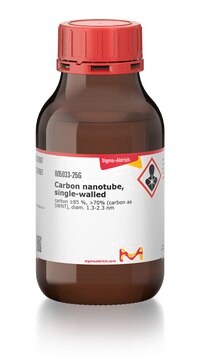755710
Carbon nanotube, single-walled
>70% (TGA), avg. no. of layers, 1
Synonym(s):
NC-1100, SWCNT, SWNT, Single wall carbon nanotube
About This Item
Recommended Products
Quality Level
Assay
>70% (TGA)
form
powder
feature
avg. no. of layers 1
manufacturer/tradename
Nanocyl, Inc.
size L
× 3 μm , TEM
average diameter
2 nm
mp
3652-3697 °C (lit.)
density
1.7-1.9 g/cm3 at 25 °C (lit.)
SMILES string
[C]
Looking for similar products? Visit Product Comparison Guide
Related Categories
General description
Application
Preparation Note
Legal Information
Storage Class Code
11 - Combustible Solids
WGK
WGK 3
Flash Point(F)
Not applicable
Flash Point(C)
Not applicable
Regulatory Listings
Regulatory Listings are mainly provided for chemical products. Only limited information can be provided here for non-chemical products. No entry means none of the components are listed. It is the user’s obligation to ensure the safe and legal use of the product.
ISHL Indicated Name
Substances Subject to be Indicated Names
ISHL Notified Names
Substances Subject to be Notified Names
JAN Code
755710-1G:4.548173315065E12
755710-250MG:4.548173314174E12
Certificates of Analysis (COA)
Search for Certificates of Analysis (COA) by entering the products Lot/Batch Number. Lot and Batch Numbers can be found on a product’s label following the words ‘Lot’ or ‘Batch’.
Already Own This Product?
Find documentation for the products that you have recently purchased in the Document Library.
Customers Also Viewed
Articles
3D printing is a type of additive manufacturing that can be used to rapidly fabricate components with highly customizable geometries.
Carbon nanomaterials (CNMs), such as single-walled carbon nanotubes (SWCNTs), multi-walled carbon nanotubes (MWCNTs), and graphene (Figure 1), have diverse commercial applications including lighter and stronger composite materials, improved energy storage devices, more sensitive sensors, and smaller transistors.
Boron nitride nanotubes (BNNT) are close structural analogs of carbon nanotubes (CNT), which are high aspect ratio nanotubular material, where carbon atoms are alternately substituted by nitrogen and boron atoms.
Carbon nanotubes (CNTs) have received much attention since their discovery in 1991 by Sumio lijima1 due to their excellent mechanical, electrical, and optical properties.
Protocols
Single-Walled Carbon Nanotubes synthesized by the Super-Growth Method & their properties & applications, including dispersing SGCNTs, SGCNT-polymer composites & SGCNT-metal composites are discussed.
Our team of scientists has experience in all areas of research including Life Science, Material Science, Chemical Synthesis, Chromatography, Analytical and many others.
Contact Technical Service



